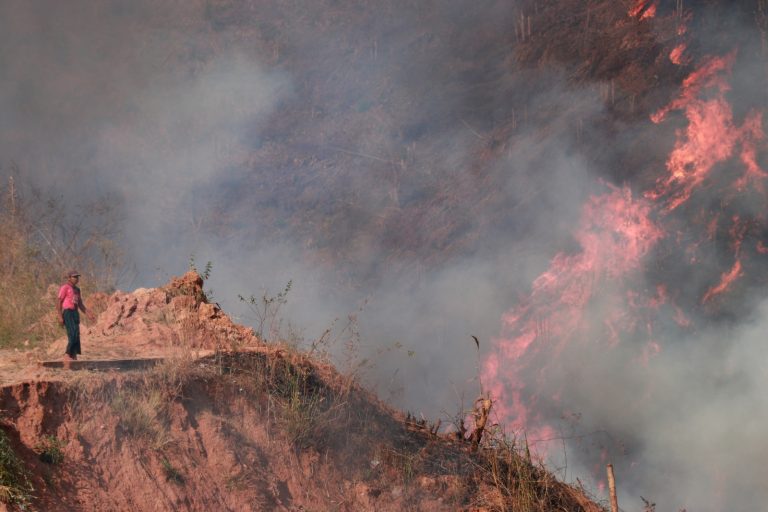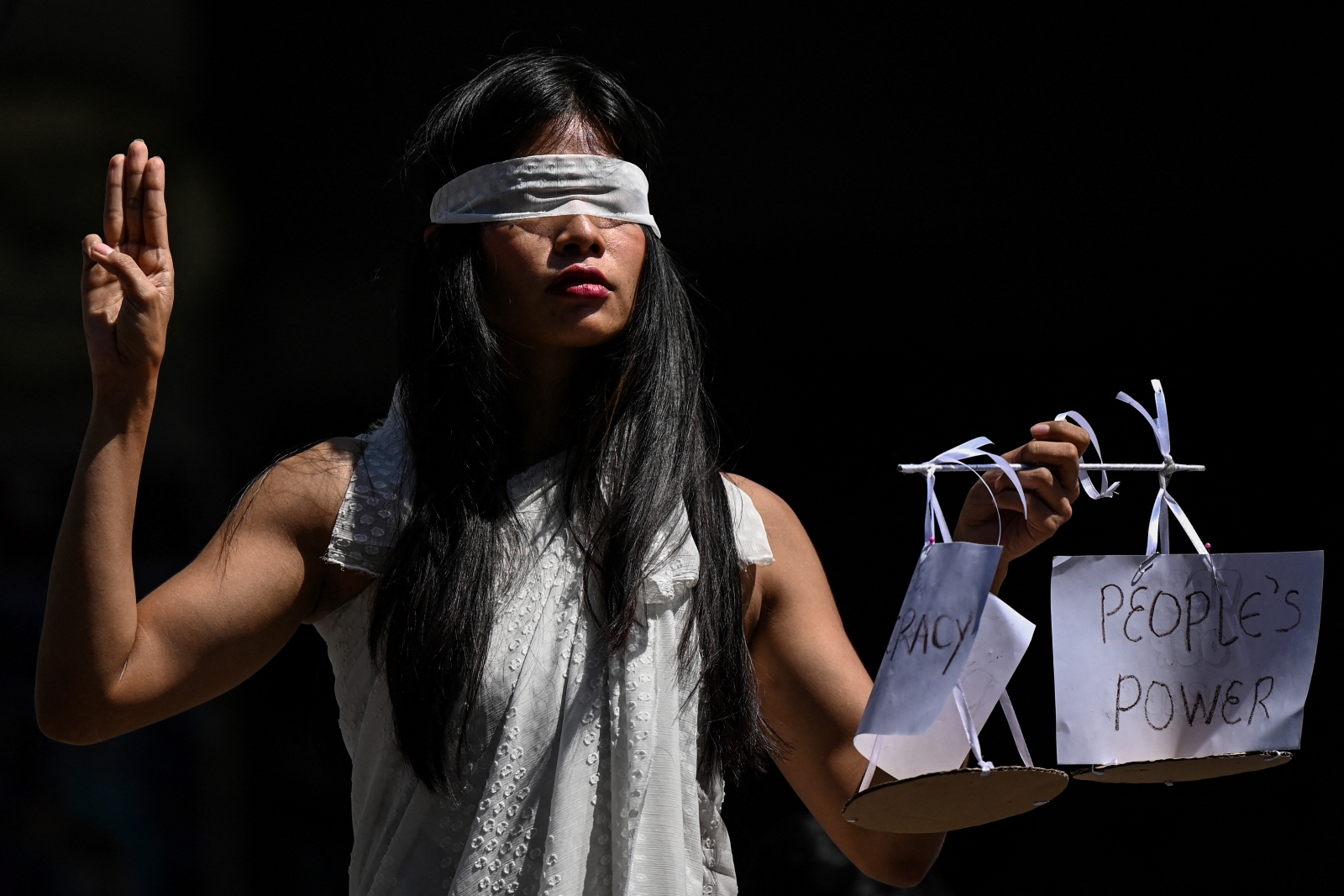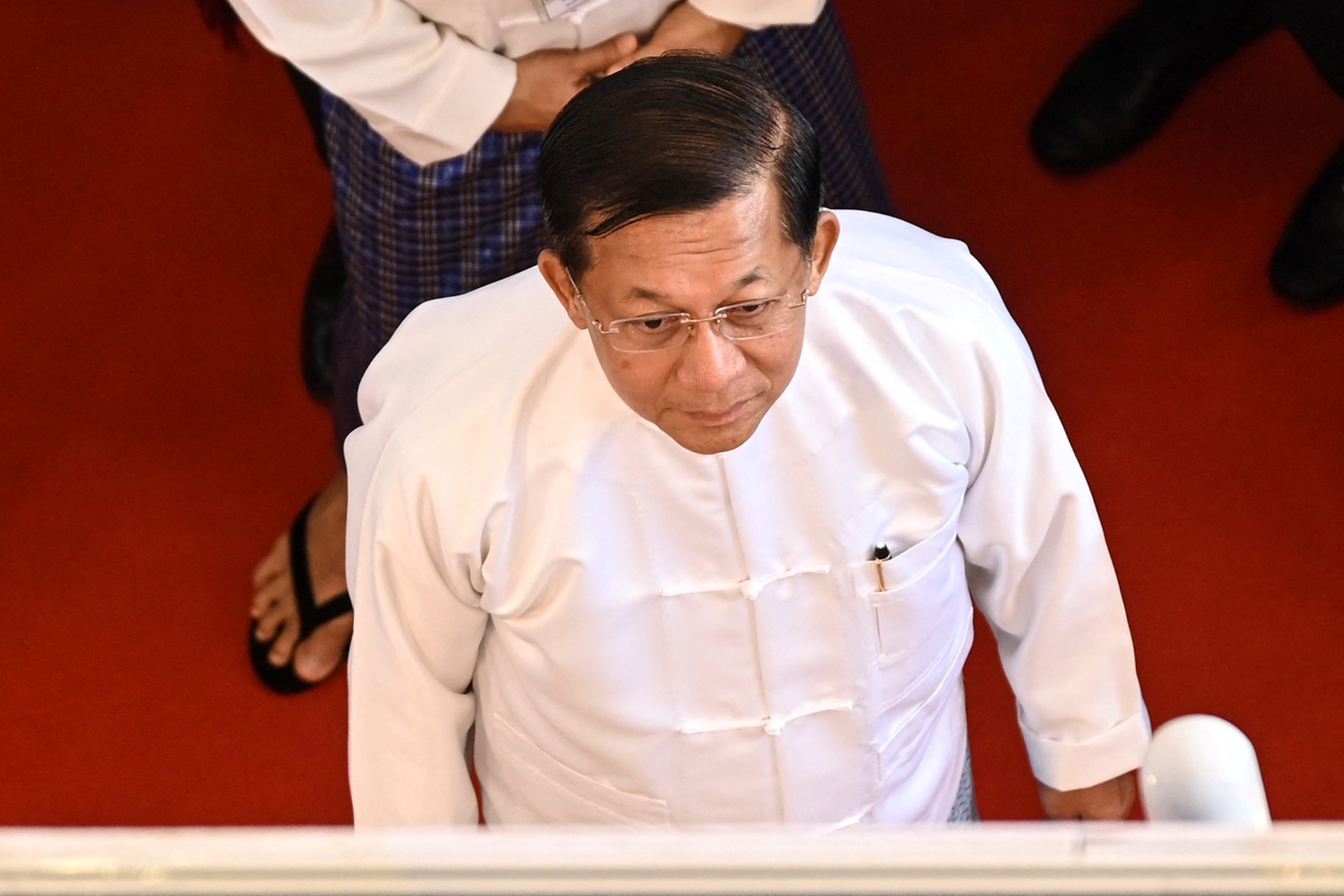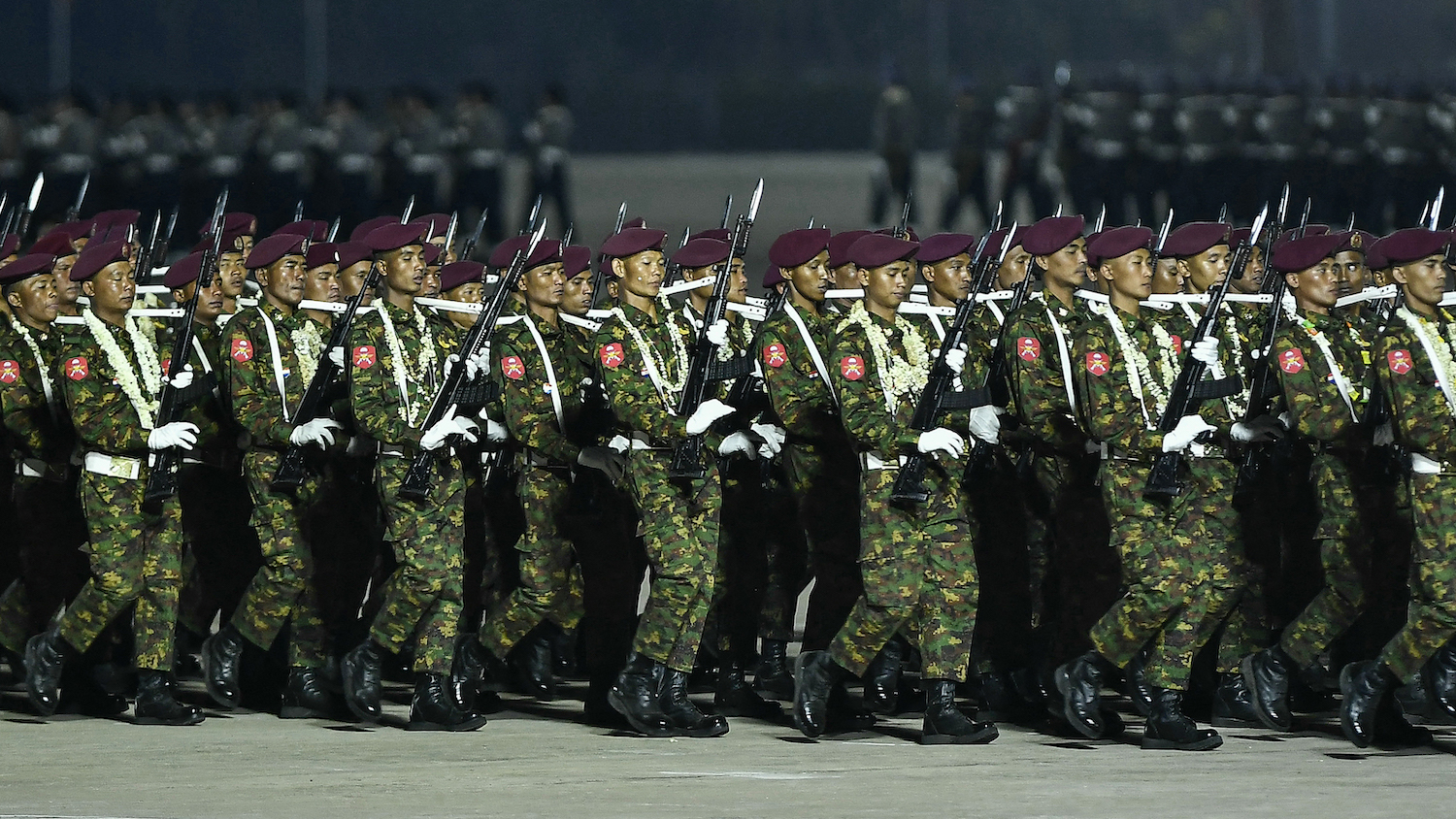In a remote, mountainous area of northern Shan State, six women are dead. Are they the latest victims of Tatmadaw impunity in the country’s long-running civil conflicts?
By CLARE HAMMOND, KYAW LIN HTOON and VICTORIA MILKO | FRONTIER
A WHITE-GREY pile of human bones and ashes fills a shallow grave on a mountain near Oi Law village in Namkham Township. The mound contains what residents say are the remains of six female Ta’ang National Liberation Army medics who were killed by Tatmadaw soldiers last month.
Standing at the graveside is the brother of one of the victims, who joined the search for the women after they went missing.
“I tried to make myself strong, as much as I could, until I saw her dead body,” he said of his sister. “The skull was cracked and there was no brain inside – the skull was empty. Her face had kept its shape, so we could identify her, but if you touched it, it disintegrated.”
Exactly what happened in the hours before the medics were killed is unclear. Both the Tatmadaw and the TNLA have issued statements; the Tatmadaw was quick to exonerate its soldiers and claims the women were killed in the course of battle, while the TNLA has said they were detained, raped, tortured and murdered.
Support more independent journalism like this. Sign up to be a Frontier member.
If the latter is true, those responsible may be guilty of war crimes under international human rights law. But the killings are largely unremarkable, and certainly not unusual: for decades ethnic minority groups have documented torture, rape and other atrocities, which they say are used as weapons of war.
Despite increasing calls for justice and accountability, the killings highlight a grim reality of Myanmar’s long-running and mostly slow-burning conflicts. Communities in many parts of the country are caught up in a war that shows no sign of ending, while those responsible for the violence continue to act with impunity.
A fatal encounter
On July 11, a column of about 30 Tatmadaw soldiers walked north along a mountain path towards Oi Law village, in northern Shan State. The route shadows the Shwe oil and gas pipelines that link Kyaukphyu in Rakhine State with China’s Yunnan Province, and whose construction earlier this decade augmented the militarisation of this remote corner of northern Shan State.

The mountain path near Oi Law village that leads to a narrow road where the gunfight took place. (Staff | Frontier)
The soldiers – residents and Ta’ang activists said the troops were from the Tatmadaw’s 88th Light Infantry Division – turned onto a narrow road; on one side a mountain rises sharply, on the other is a cliff. On that stretch of the road, at about 1.30pm, they encountered a group of TNLA members, who were hitching a ride with Chinese employees of a mining company, New Day Asia.
That’s about all that everyone agrees on: from here, accounts of that day’s events begin to diverge. The Tatmadaw has said its troops met 30 “insurgents” on the road, including five women, while conducting “area clearance operations”.
The TNLA said that 13 of its members were travelling in two cars – five soldiers in the first car, two soldiers and six medics in the second. It said the convoy was ambushed and that two of the TNLA soldiers fired at the Tatmadaw.
Villagers from Oi Law, meanwhile, told Frontier they found the bodies of seven people: one TNLA soldier who they believe was killed on the spot and six medics, who they say were captured with three Chinese mine workers and then detained separately. The other TNLA soldiers appear to have escaped.
Oi Law is about 2 kilometres away. Villagers said they heard a gunfight and that it lasted for seven or eight minutes. They also recalled hearing three explosions. The Tatmadaw said the surviving TNLA soldiers retreated to the north about 20 minutes after the initial encounter.
A statement released on Facebook by the Tatmadaw’s True News Information Team, said its soldiers “seized” a Toyota truck “that was damaged after being plunged down a ravine” along with the bodies of three men and five women in camouflage uniforms, and a cache of guns and grenades.
Villagers dispute that the car came off the road during the fight, telling Frontier they could see it on the road that evening, but by the next morning it had been pushed over the cliff. The Tatmadaw statement said some three hours after the gunfight, at 5pm, the bodies were “properly buried near the scene”. It does not reveal what happened in the interim and Frontier was unable to reach Tatmadaw spokespeople for further comment.

A car that villagers said was carrying the TNLA medics remained at the scene, along with bullet casings and other weapons. (Staff | Frontier)
The Tatmadaw soldiers then appear to have spent the night beside the road. Frontier saw the remains of several pit fires where villagers said the soldiers had made their campsite. It was metres away from a grave where they said the TNLA soldier was originally buried; his body was later moved into the forest, near those of the medics.
Frontier found over 50 bullet casings at the scene, which had markings that specialists said indicated they had probably been produced at a Tatmadaw munitions factory, although it is impossible to confirm who fired them.
The morning after the shootout, villagers say the Tatmadaw soldiers went to Oi Law with three Chinese mine employees and ordered the village head to avoid the site of the fighting for five days. They said the soldiers then took two of the mine employees, who were injured, to a hospital in Mansi Township in neighbouring Kachin State.
Destroyed evidence
Despite the order to stay away from the area, the following evening a search party including residents of Oi Law ventured out to look for the medics. Members of the group told Frontier they were cautious at first because they feared the Tatmadaw might have planted landmines.
The following day – July 14 – they found a heap of soil weighed down with rocks on an overgrown mountain path. Underneath it were the stacked bodies of six women, residents said. Those who found the bodies said that the women had multiple cuts and wounds, as well as signs of mutilation.
“Three of the women had lost the backs of their skulls. All the villagers believed they were tortured and then killed and some believe they were raped,” said a spokesperson for the Ta’ang Women’s Organization, which sent representatives to the area after the incident to document the case.
According to the brother of a victim, one of the women was not wearing underwear when they found her body. The others appeared to have been carelessly re-clothed, which he said suggested they had been sexually assaulted before they died.
After exhuming the bodies, TNLA representatives took photographs, villagers said. One of these was posted on July 16 to the group’s official Facebook page. They cremated the bodies that day, where they found them, on two pyres: one for the medics, another for the soldier. Video footage obtained by Frontier appeared to show an individual performing funeral rites before the bodies were burned.

A video obtained by Frontier shows the recovered bodies covered in a blanket shortly before they were cremated. (Photo | Supplied)
Villagers say TNLA soldiers ordered them to delete photographs from their phones and refused to allow families to collect the remains for a traditional ceremony because the group intended to build a memorial elsewhere. They believed they were told to delete footage for their “security” and said they obeyed instructions.
TNLA spokesperson Major Mai Aik Kyaw told Frontier the order was intended to prevent photos and videos from going viral on social media. “That could violate the rights of the deceased and their families,” he said. TNLA members had first conducted a “forensic investigation” he added, saying it was traditional for the TNLA to cremeate its members killed in conflict without delay.
However, Yangon-based analyst Mr David Mathieson said it was “very unusual” for the TNLA to instruct civilians to destroy evidence when a case is still open. If the incident unfolded as the TNLA described, then the photo evidence could have been used to compel the Tatmadaw to conduct a proper investigation. But he also noted that visual evidence supplied by ethnic armed groups is not axiomatically credible.
“All armed groups engage in distortion of facts down to outright fabrication, and they regularly intimidate civilians to stay tight-lipped on their own human rights violations,” he said. “If the TNLA is intimidating witnesses it appears guilty of a cover-up, and should be committing to a proper investigation to seek justice for those who were killed.”
Asked whether the TNLA would seek an independent investigation, Mai Aik Kyaw said it would not, but that it “strongly called on Tatmadaw leaders to investigate this inhumane case” and to take action against those responsible.
A detailed Burmese-language statement issued by the TNLA on August 6 complicates the picture further. It said the medics were “brutally tortured and raped” through the night of July 11 and executed the following morning. This account, it said, was based on testimony from four drivers from the mining company, who were captured with the medics, and local villagers.
The drivers reportedly told the TNLA the medics were arrested during the gunfight on the afternoon of July 11, then blindfolded and taken away as “prisoners of war”. The statement said the mining company employees were held around 200 metres away from the women, on the other side of the hill, and they reported hearing “the cry and wail of the medics the whole night”.
It concludes that the medics were killed between 8am and 9am on July 12 because “villagers said they heard the sound of gunfire at that time from the place where the medics were kept”. However, when Frontier visited the village last month, none of the villagers mentioned having heard gunfire on July 12, though they described the sounds of the gunfight on July 11 in detail.
Mai Aik Kyaw said he didn’t know why they failed to mention the second round of gunfire to Frontier. “We, the TNLA, did not shut their mouths. Whatever they know, they can say to media. I think perhaps they forgot it, or were afraid to speak out.”
Forced recruitment
For years civil society groups have accused the Tatmadaw of employing a systematic pattern of torture, sexual violence and extrajudicial killing in conflict areas, including in parts of northern Shan State home to the Ta’ang.
Local and international groups have also documented similar atrocities in other parts of the country, notably in Kachin and Rakhine states. Some of the most brutal assaults have been attributed to the army’s light infantry divisions, including the 88th, which specialise in counter insurgency and jungle warfare.
Ethnic armed organisations such as the TNLA have also been accused of war crimes, particularly in northern Shan State, where villagers have reported abductions and killings. The UN said in its most recent annual report on acts of violence by armed forces that two members of the TNLA allegedly committed rape in October 2017, while villagers in Oi Law told Frontier the Ta’ang army has a policy of forced recruitment.
They said the TNLA expected at least one member of each family to enlist. The brother of the medic denied this amounted to forced recruitment; civilians were happy “to join the revolution”, he said. It was not clear whether he was speaking freely, however, as the area is under the influence of the TNLA’s Brigade 1 and another villager was recording the interview.
His sister volunteered to join the army, he said, because their younger siblings were at school and the family also felt it would be safer for a woman to enroll. The night before she died, his sister told him by telephone that she wanted to leave the TNLA and asked if he might take her place. Her feet were badly cut from trekking through the jungle, he said, and she was exhausted.
Mai Aik Kyaw said the TNLA required every Ta’ang family with two or more sons aged between 18 and 35 to send one to serve in the army. “Since we started the revolution, most of the men who are qualified to enlist join our army willingly,” he said.
“In some villages we need to go around and inform those families with eligible men [about our recruitment policy] although we don’t penalise those who do not join.” He said the TNLA only recruited men and that its female members joined voluntarily. “Mostly we appoint them as medics after their training,” he said. “Among siblings, if a woman is serving with the TNLA, we don’t require her brothers to join.”

typeof=

A TNLA calendar showing male and female recruits hangs in a house in Oi Law (above) and a photograph of one of the six medics is shown on a mobile phone. (Staff | Frontier)
The brother of the medic suggested that the TNLA was partly responsible for her death. While the Tatmadaw’s actions were “inhumane” he said, the TNLA could have better protected the women. “Since they are girls and since they are only medics, they should [have given] them sufficient security for their lives.”
The TNLA said in its first statement that two soldiers were responsible for the medics’ security; one was shot dead and the other escaped.
A legacy of impunity
Above all, the killings highlight the vulnerability of communities in conflict areas. Most are remote and difficult to access; Oi Law is a two-day walk or five-hour motorbike ride from Namtu, the nearest town. Villagers say there are no police stationed in Oi Law or in the surrounding villages and that the administrators are elder members of the Ta’ang community who report to the TNLA.
The lack of protection in villages across northern Shan has prompted many to leave their homes for the safety of Namtu and other towns. For years, thousands of displaced Shan, Kachin and Lisu have lived in camps.
Several camp residents in Namtu and Muse told Frontier they did not want to return home because they felt too vulnerable in their villages, through which columns of Tatmadaw and ethnic soldiers often pass.

The TNLA requires families to provide children for military service, but says it rarely has to enforce the rules because most enlist voluntarily (Steve Tickner | Frontier)
The remoteness means atrocities can go unreported and undocumented, although this is slowly changing. The national rollout of mobile phone networks since late 2014 and proliferation of camera-equipped smartphones has enabled civilians to document and share evidence of extrajudicial killings, torture, sexual violence and the destruction of property, mostly on Facebook.
This has sometimes forced the Tatmadaw to issue statements defending its soldiers’ actions, or even to admit that abuses have taken place.
In recent years, the Tatmadaw has – under pressure from locals – occasionally punished soldiers involved in human rights abuses, although its military tribunals are secretive and there is no evidence that convicted soldiers serve their sentences.
There are several other major obstacles to justice. In its 2018 report Seeking Accountability for Ending Impunity in Burma, the Legal Aid Network said Myanmar’s laws tend to conflict with international laws, including the Geneva Conventions to which Myanmar is a party. The report also pointed out that the Tatmadaw is still exempt from civilian oversight under the 2008 Constitution.
“At the national level, due to lack of jurisdiction, independent existence and competency, civilian courts are unable and unwilling to seek accountability for heinous crimes allegedly committed by the Myanmar army,” the report said.
At the grave near Oi Law, the brother of one of the victims crouched and picked up a bone from the pile. Asked if he believed in the potential for justice, he said he was not even sure if any laws were violated.
“This kind of thing is really terrible and inhumane so I am wondering if there are laws or agreements [that prohibit such acts],” he said. “What I mostly hope is that all the people can know the real case, how it happened … I want them to find the truth.”







